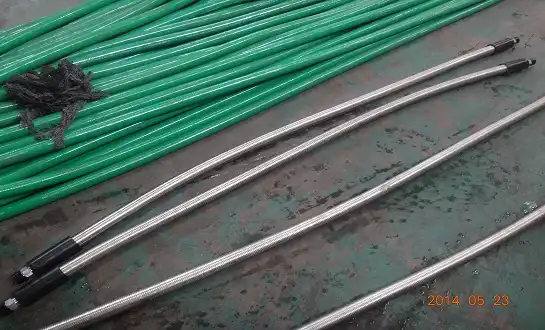Key Features to Consider When Selecting BOP Hoses
When it comes to ensuring the safety and efficiency of drilling operations, selecting the right BOP hoses is crucial. Blowout Preventer (BOP) hoses play a vital role in hydraulic control systems, connecting the BOP stack to the control unit. The selection process involves carefully evaluating several key features to ensure optimal performance, durability, and reliability in challenging oilfield environments. This article will guide you through the essential characteristics to consider when choosing BOP hoses, helping you make an informed decision that enhances your drilling operations' safety and productivity.

Pressure Rating and Working Pressure
One of the most critical factors to consider when selecting BOP hoses is their pressure rating and working pressure capabilities. These hoses must withstand extreme pressures during drilling operations, making it essential to choose hoses that meet or exceed the required pressure specifications for your specific application.
Understanding Pressure Ratings
The pressure rating indicates the maximum pressure a hose can safely handle before it risks failure. BOP hoses are designed to withstand extreme pressures encountered during drilling operations, so it's essential to choose hoses with a pressure rating that meets or exceeds the specifications for your specific application.
Typically, BOP hoses have pressure ratings that range from 3,000 psi to 15,000 psi, and in some cases, even higher, depending on the operational environment and requirements. It's crucial to ensure the hose selected is capable of handling the maximum pressure expected during drilling, with a sufficient safety margin to prevent accidents and equipment failure.
Working Pressure Considerations
The working pressure of BOP hoses refers to the maximum pressure at which the hose can function safely under normal operational conditions. It's important to ensure that the working pressure rating aligns with the pressures typically encountered in the drilling environment.
For optimal performance, select hoses whose working pressure is well-suited to your drilling operations, whether onshore or offshore. This consideration ensures that the hoses can maintain structural integrity and prevent leakage or rupture, which could lead to safety hazards or operational delays. Properly rated hoses contribute to the overall reliability and efficiency of well control systems, making the selection of the right hose a vital part of a safe and successful drilling operation.
Temperature Range and Chemical Compatibility
Drilling operations often involve exposure to extreme temperatures and various chemicals. Therefore, it's essential to consider the temperature range and chemical compatibility of BOP hoses when making your selection.
Temperature Resistance
BOP hoses are subjected to a wide variety of temperature conditions during drilling operations. These can range from freezing cold on offshore rigs to intense heat from the drilling process itself. For this reason, selecting a hose with the appropriate temperature range is crucial.
Most BOP hoses are designed to operate within a temperature range of -40°C to +121°C, but some hoses may be rated for even higher temperatures, depending on the specific needs of the drilling environment. It's important to choose hoses that can handle both the high and low temperature extremes expected during operation without compromising their performance or structural integrity. Hoses that cannot tolerate these fluctuations may degrade quickly, resulting in leaks or failures that can jeopardize safety and productivity on the rig.
Chemical Compatibility
Another key consideration when selecting BOP hoses is their chemical compatibility. Drilling operations involve the use of various chemicals, including hydraulic fluids, lubricants, drilling muds, and other aggressive fluids that could potentially damage the hose material.
To ensure the longevity and reliability of the hoses, it's vital to choose hoses made from materials that are resistant to the specific chemicals encountered in the operational environment. If a hose is not chemically compatible, it may degrade, swell, crack, or become brittle over time, leading to hose failure and safety risks. Before making a selection, it's essential to verify the hose material's resistance to common drilling chemicals and ensure it meets the required specifications for your operational needs. Proper chemical compatibility will help extend the lifespan of the hose and reduce the risk of costly downtime or accidents.
Durability and Construction Materials
The harsh conditions of drilling environments demand BOP hoses that are built to last. Consider the durability and construction materials used in the hoses to ensure they can withstand the rigors of oilfield operations.
Reinforcement Layers
The durability of BOP hoses is largely determined by the reinforcement layers used in their construction. High-quality hoses typically feature multiple reinforcement layers made from materials like steel wire braiding or high-strength synthetic fibers. These reinforcement layers are crucial for providing the necessary strength to withstand the extreme pressures encountered in drilling operations.
Additionally, they enhance the hose's flexibility, allowing it to bend and move without compromising its structural integrity. The strength of these layers also helps protect the hose from internal and external forces, such as pressure surges or mechanical stresses, ensuring that the hose maintains optimal performance even under challenging conditions. A robust reinforcement design helps minimize the risk of hose failure, thus improving safety and efficiency during drilling operations.
Outer Cover Materials
The outer cover of BOP hoses plays an equally important role in their durability, as it must withstand exposure to harsh environmental conditions, including abrasion, weathering, and ozone degradation. Common materials used for the outer cover include neoprene or specially formulated synthetic rubbers, which are selected for their exceptional resistance to these environmental factors. These materials ensure that the hose remains functional and intact even after prolonged exposure to UV rays, extreme temperatures, and chemical spills commonly found in drilling environments.
The outer cover also provides an additional layer of protection against physical damage caused by rough handling, friction, or contact with sharp objects on the rig floor. By choosing hoses with durable outer covers, operators can extend the lifespan of the equipment and minimize downtime due to hose wear or damage.
Conclusion
Selecting the right BOP hoses is a critical decision that directly impacts the safety and efficiency of drilling operations. By carefully considering factors such as pressure ratings, temperature resistance, chemical compatibility, and durability, you can ensure that your chosen hoses meet the demanding requirements of oilfield environments. Remember to consult with reputable manufacturers and suppliers who can provide expert guidance and high-quality products tailored to your specific needs.
FAQ
1. How often should BOP hoses be replaced?
The replacement frequency of BOP hoses depends on various factors, including usage intensity, environmental conditions, and manufacturer recommendations. Generally, it's advisable to inspect hoses regularly and replace them every 3-5 years or sooner if signs of wear or damage are detected.
2. Can BOP hoses be repaired if damaged?
In most cases, it's not recommended to repair damaged BOP hoses due to the critical nature of their function and the high pressures involved. It's safer and more reliable to replace damaged hoses with new ones to ensure optimal performance and safety.
3. Are there industry standards for BOP hose specifications?
Yes, there are industry standards that govern BOP hose specifications, such as those set by the American Petroleum Institute (API) and the International Organization for Standardization (ISO). These standards provide guidelines for pressure ratings, materials, and testing procedures to ensure the quality and reliability of BOP hoses.
Choose WELONG for Superior BOP Hoses and Expert Support
When it comes to selecting high-quality BOP hoses for your drilling operations, WELONG stands out as a trusted supplier with over 20 years of experience in the oilfield industry. Our comprehensive range of BOP hoses is designed to meet the most demanding requirements, featuring working pressures up to 10,000 psi and temperature ranges from -40°C to +121°C. With our ISO 9001:2015 and API 7-1 certifications, you can trust in the quality and reliability of our products.
At WELONG, we understand the critical nature of BOP hoses in ensuring safe and efficient drilling operations. Our expert team is ready to assist you in selecting the perfect BOP hoses for your specific needs, offering customized solutions and unparalleled support. Don't compromise on safety and performance – choose WELONG as your trusted BOP hoses supplier.
For more information or to discuss your BOP hose requirements, please contact our dedicated team at oiltools15@welongpost.com. Let WELONG be your partner in elevating your drilling operations to new heights of safety and efficiency.
References
- American Petroleum Institute. (2021). "Specification for BOP Hose Assemblies." API Specification 16C, 3rd Edition.
- International Organization for Standardization. (2019). "Petroleum and natural gas industries — Drilling and production equipment — Specification for control systems for drilling well control equipment and control systems for diverter equipment." ISO 13628-6:2019.
- Society of Petroleum Engineers. (2020). "Best Practices for Blowout Preventer (BOP) Systems Maintenance and Inspection." SPE Technical Report.
- Offshore Technology Conference. (2022). "Advancements in BOP Hose Design for Deepwater Applications." OTC-31234-MS.
- Journal of Petroleum Technology. (2023). "Improving BOP Reliability Through Enhanced Hose Selection and Maintenance Strategies." JPT, Vol. 75, No. 4.
- Drilling Contractor Magazine. (2022). "Innovations in BOP Hose Materials for Extreme Environment Performance." September/October Issue.

Share your inquiry, get the quotation accordingly!

CHINA WELONG - 20+ years manufactuer in oilfield tools


